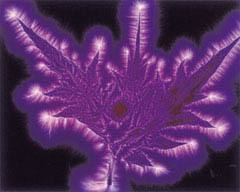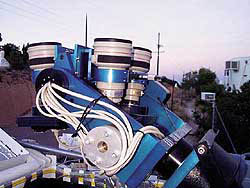
대기층은 그 자체가 매우 흥미로운 현상이다. 강한 중력이 있는 천체는 가스분자들을 붙잡아 우주로 탈출하지 못하도록 막는다. 따라서 달이나 수성처럼 작은 세계엔 대기층이 없고 화성엔 매우 얇은 대기층이 있을 뿐이다. 지구나 금성은 두터운 대기층을 갖고 있다.
강한 중력만이 대기층을 형성하는 유일한 힘은 아니다. 천체의 온도가 차가울수록 주위의 가스분자들은 천천히 움직이면서 표면에 보다 쉽게 붙잡혀 있게 된다. 목성의 위성들은 그중 네개는 제법 큰 것임에도 불구하고 대기층을 갖기엔 아직도 너무 따뜻하다. 토성의 위성중 가장 크고 태양계에서는 두번째로 큰 위성 타이탄은 훨씬 차가우며 따라서 대기층을 가질 수 있다. 트리톤(해왕성의 위성)과 명왕성은 더욱 차가워 역시 대기층에 둘러 싸여 있다.
이들 사이에 차이가 있다면 트리톤과 명왕성은 대기층이 얇으나 타이탄의 대기층은 두꺼우며 지구의 대기층보다 밀도가 높다는 점일 것이다.
이제 떠오르는 질문은 타이탄 대기층의 정체가 과연 무엇이냐는 것이다. 지난 1944년 타이탄의 대기층이 제라드 쿠이퍼씨에 의해 처음 발견되었을 때 그 대개는 흔한 가스인 메탄으로 얇은 층을 이루고 있는 것처럼 보였다.
타이탄의 대기층은 지구 대기층밀도의 1, 2%정도 밖에 안되는 것처럼 보였다. 문제는 메탄가스가 탐지하기 쉬운 화합물이라는 점이다. 만약 탐지하기 힘든 다른 가스가 존재한다면 어땠을까? 탐지불가능한 가스로 생각해 볼 수 있는 후보로는 질소가 있다.
그러나 우주탐사용 로켓시대가 열리기 전까지는 타이탄을 가까이서 관찰할 수가 없었다. 어찌 보면 예전엔 실망할 수밖에 없던 것이 대기층이 너무 탁해 아무 것도 보이지 않아서 타이탄은 특징이라고는 없는 오렌지색깔의 원형천체로만 여겨졌던 것이다.
하지만 이제 타이탄의 대기층을 뚫고 들어간 우주탐사기는 타이탄의 대기가 대부분 질소며 어쩌면 90% 가까이까지 질소일 것이라는 놀랄만한 뉴스를 보내왔다. 바로 그점이 타이탄의 대기층 밀도를 그토록 높게 만들었던 것이다.
이 사실은 매우 흥미로울 수밖에 없는데 태양계에서 알려진 천체중에서 오직 타이탄과 지구의 대기층만이 대부분 질소라는 점 때문이다. 큰 행성들의 대기는 대부분 수소다. 화성과 금성의 대기는 대부분 이산화탄소로 되어 있다.
그렇다면 타이탄의 질소가 어디로부터 왔느냐는 두번째의 질문이 떠오른다. 이 질문에 대한 한가지 답은 타이탄의 내부구조로부터 왔다는 것이다. 타이탄의 중심부는 본질적으로는 바위지만 낮은 온도때문에 다이아몬드처럼 매우 단단한 얼음층으로 둘러싸여 있다.
그래서 타이탄의 유년시절 얼음층이 형성될 때 그안에 질소를 가두지 않았겠느냐는(질소는 그와 같은 조건에선 쉽게 갇힐 수 있다) 주장이 펼쳐진 바 있다. 그후 수십억년이 지나면서 질소가 새어나와 대기층을 형성하지 않았을까 하는 것이다.
그러나 이러한 주장은 질문에 대한 답을 제대로 해주진 못한다. 도대체 질소가 처음에 어디로부터 온 것일까?
그렇다면 다른 가능성을 들어보자. 다른 거대한 행성과 마찬가지로 토성은 그 대기층에 상당한 양의 암모니아 가스를 가지고 있다. 암모니아는 질소와 수소로 만들어진다. 만일 타이탄이 토성으로부터 암모니아를 얻었다면 적외선이 암모니아를 깨부수어 평범한 질소와 수소로 만들었을 것이다. 수소는 매우 작은 원자로 구성되어 있다. 원자의 크기가 작을수록 더 빨리 움직이므로 타이탄은 이 수소원자들을 붙잡지 못하고 더 무거운 질소원자들만 붙잡아 두었던 것이다.
문제는 그와같은 반응이 나타나려면 타이탄이 현재의 온도보다 훨씬 따뜻해야 한다는 점이다. 예전의 타이탄이 더 따뜻했었는지는 모를 일이다. 그러나 아직은 미지수이기 때문에 이 문제는 천문학자들이 해명해야할 과제로 남아있다.
한편 레이더로 밝혀진 최근의 연구자료는 타이탄이 공전함에 따라 반사되는 빛이 달라진다는 것을 보여주고 있다. 이 현상에 대한 가장 좋은 설명은 타이탄의 일부는 단단한 표면이요 일부는 액체라는 것임이 분명하다. 단단한 표면은 단단한 얼음대륙이다. 그러나 액체는 무엇으로 만들어졌을까 하는 의문이 생긴다.
타이탄 대기중의 메탄은 적외선에 의해 쉽게 변형되어 일종의 쌍 메탄분자인 에탄으로 바뀐다. 메탄은 타이탄의 찬 온도속에서도 가스형태를 유지하지만 에탄은 액체이므로 최근의 생각은 타이탄이 넓은 에탄바다를 갖고 있다는 쪽으로 모아지고 있다.
이는 매우 흥미로운 사실인데 에탄은 천연가스와 휘발유의 중간형태쯤 되기 때문이다. 에탄은 불에 매우 잘 타며 기름처럼 에너지를 제공한다. 사실 타이탄은 태양계에서 가장 큰 정유소로 밝혀질는지도 모를 일이다.
당연하게도 우리는 그 에탄을 담아 다른 곳에서 활용하고자 옮기는 장면을 상상해 볼 수 있다. 그럴수만 있다면 인류가 멸망할 때까지 타이탄은 충분한 에너지 공급원이 될 수 있을 것이다.
그러나 문제가 하나 있다(언제나 그렇듯이). 타이탄은 너무 멀리있어 거기까지 가서 에탄을 담아 이것을 활용할 수 있는 태양계 내부의 다른 곳으로 가져오는 것에는 감당하지 못할 정도로 많은 비용이 소요된다. 어쩌면 언젠가 이 작업을 보다 값싸게 수행할 수 있는 방안을 강구할 수 있을는지 모르겠으나, 솔직히 말해 필자의 머리속엔 단 하나의 방안도 떠오르지 않는다.
Atmospheres are an interesting phenomenon. Huge worlds with strong gravity can hold on to gas molecules and keep them from escaping into space. Thus, the moon and Mercury, small worlds, do not have an atmosphere, and Mars has only a thin one. Earth and Venus have thick atmospheres.
Strong gravity is not the only way in which an atmosphere can be held. The colder a world is the more slowly the molecules of gas about it can move and the more easily they can be held to the surface. The satellites of Jupiter-even though four of them are relatively large-are still too warm to hold an atmosphere. Titan, the largest satellite of Saturn and the second largest in the solar system, is much colder and can hold an atmosphere. The still colder worlds of Triton(Neptune's satellite) and Pluto also have atmospheres.
The difference is this : Triton and Pluto have only thin atmospheres but Titan's is thick, denser than Earth's.
The question arises : What is the nature of Titan's atmosphere? When the atmosphere was first detected by Gerard Kuiper in 1944, it seemed that the atmosphere was made up of a thin layer of methane, a very common gas.
It seemed only 1 or 2 percent as dense as Earth's. The trouble is that methane is an easy compound to detect. What if other gases were present that were harder to detect? The logical candidate for such an undetectable gas would be nitrogen.
It was not until the time of the planetary probes, however, that Titan could be observed closely. In a way, it was disappointing, for it seemed only a featureless orange globe with nothing visible because the atmosphere was so hazy.
Probes, however, that entered Titan's atmosphere sent back the astounding news that it was largely nitrogen, maybe up to 90 percent nitrogen. That was what made Titan's atmosphere so dense.
This is interesting because among the known bodies in the solar system, only Titan and Earth have atmospheres that are largely nitrogen. The giant planets have atmospheres that are mostly hydrogen. Mars and Venus have atmospheres that are mostly carbon dioxide.
Next question : Where did the nitrogen come from? One possible answer arises from the internal structure of Titan. The central portions of Titan are rocky in nature, but around that rock is a thick layer of ice--diamond-hard because of the low temperatures.
It has been suggested that in Titan's earliest days, as the ice layer formed, it trapped nitrogen(which, apparently, is easily trapped under such conditions). Then, as the billions of years passed, the nitrogen leaked out and formed the atmosphere.
But that doesn't really answer the question. Where did the nitrogen come in the first place?
Another suggestion : Saturn, like the other giant planets, has considerable ammonia in its atmosphere. Ammonia is made up of nitrogen and hydrogen. If Titan picked up ammonia from Saturn, then ultraviolet light would break it up into plain nitrogen and plain hydrogen. The hydrogen is made up of very small atoms. The smaller the atom, the faster it moves, and Titan wouldn't be able to hold on to it, but it could hold on to the heavier atoms of nitrogen.
The problem is that Titan would have to be considerably warmer than it is for such a reaction to take place. Well, perhaps Titan was warmer in very early time, but we don't know-so this remains a problem for astronomers to play with.
Recent studies by radar show that the reflections vary as Titan turns. Apparently, the best explanation for this is that Titan consists of part solid surface and part liquid. The solid surfaces are continents of hard ice. The question is : What is the liquid composed of?
The methane in Titan's atmosphere is easily altered by ultraviolet light and converted to ethane, which is a kind of double molecule of methane.
Methane remains a gas even at Titan's low temperature, but ethane is a liquid, so the current thinking is that Titan has a large ethane ocean.
This is very interesting because ethane is sort of midway between natural gas and gasoline. It bums very nicely and supplies energy just as oil does. In fact, it might turn out that Titan is the largest oil well in the solar system.
Naturally, one imagines us as dipping up the ethane and carting it off for use elsewhere. It would be a supply that would last as long as the human race does.
But there's catch.(There always is.) Titan is so far away that to go there, collect the ethane and bring it anywhere in the inner solar system where it might be useful would be prohibitively expensive. Perhaps we will someday figure out a way to do it cheaply, but to be perfectly honest, I can't think of one.
















